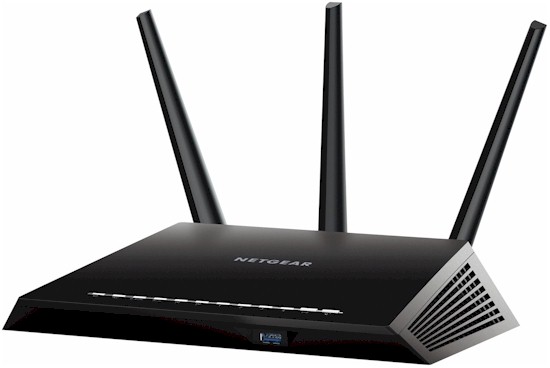
| At a glance | |
|---|---|
| Product | NETGEAR Nighthawk AC1900 Smart WiFi Router (R7000) [Website] |
| Summary | Second generation Broadcom 802.11ac AC1900 router with storage sharing USB 2.0 & 3.0 ports and OpenDNS based parental controls |
| Pros | • Has WDS, Client Bridge and AP modes • USB 3.0 port • Fast file transfers for both FAT32 & NTFS formats |
| Cons | • No site survey in client bridge mode • 600 Mbps in 2.4 GHz will rarely be experienced • Not Wi-Fi Certified • Can’t adjust transmit power |
Typical Price: $53 Buy From Amazon
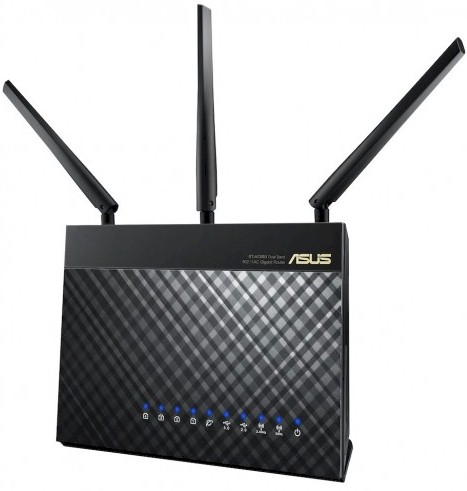
| At a glance | |
|---|---|
| Product | ASUS Dual-band Wireless-AC1900 Gigabit Router (RT-AC68U) [Website] |
| Summary | Second gen+ Broadcom-based AC1900 router with USB 2.0 & 3.0 drive and printer sharing and PPTP VPN server. |
| Pros | • Supports router, AP, media bridge and WDS bridging/repeating |
| Cons | • Nothing glaring |
Typical Price: $117 Buy From Amazon
Introduction
Some of the resident AC router fanboys over in the Forums are about to pop a blood vessel in anticipation of the first AC1900 class routers and trying to decide which to blow $200+ on. So I figured I’d better get something up sooner vs. later so that they have an alternative to the somewhat breathless reviews that other sites are posting. Rest assured that full reviews for NETGEAR’s R7000 "Nighthawk" and ASUS’ RT-AC68U will follow in the coming weeks.
As I explain in this short AC1900 primer, not many people will be able to experience the 600 Mbps link rates in 2.4 GHz that are the raison d’être for the AC1900 stew that Broadcom has cooked up. The only folks who will are those who spring for two routers and set the second up as a wireless bridge.
Even those who have the only AC1900 client device that exists—ASUS’ PCE-AC68—will likely be disappointed. ASUS sent one along with the router and I was not able to get a link above 450 Mbps on the 2.4 GHz radio. So after wasting an afternoon trying to coax a 600 Mbps link, I fired off emails to ASUS and Broadcom to let them know of the problem and fell back to my trusty old PCE-AC66. Broadcom came back after a few days and confirmed that TurboQAM is not enabled by default in the PCE-AC68 driver. So ASUS is supposedly working on a new driver that will flip the proper bit.
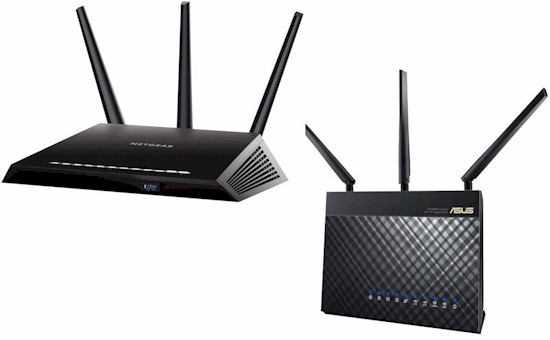
The gist of this is that this first look tests both products as AC1750 routers. If you’re looking for AC1900 results, you’ll have to wait for another week or so. Most people don’t even have AC580 or AC867 class devices anyway and buy AC routers for the folly of future-proofing or in hope of improving wireless throughput and/or range for existing G and N devices.
The other question on your mind is likely to be "where’s the Linksys EA6900"? Well, it seems that Linksys has a copy of the Octoscope MPE-based test setup I use and didn’t like the results they were seeing when they checked the first batch of routers before sending them out for review. So they missed the window to be included in this review.
Inside
Because there has been a lot of speculation about the innards of these beasties, I opened both of them up after testing was done. Table 1 tells the tale.
| NETGEAR R7000 | ASUS RT-AC68U | |
|---|---|---|
| CPU | Broadcom BCM4709A | Broadcom BCM4708A |
| Switch | in BCM4709A | In BCM4708A |
| RAM | 256 MB | 256 MB |
| Flash | 128 MB | 128 MB |
| 2.4 GHz Radio | – Broadcom BCM4360 – Skyworks SE2623L 2.4 GHz Power Amp (x3) |
– Broadcom BCM4360 – Unidentified 2.4 GHz Power Amp marked 397 649e 230(x3) |
| 5 GHz radio | – Broadcom BCM4360 – Skyworks SE5003L1 5 GHz Power Amp (x3) |
– Broadcom BCM4360 – SiGE 5023L 5 GHz Power Amp (x3) |
Table 1: Component summary
The R7000 sports a Broadcom BCM4709A SoC, while the RT-AC68U uses the Broadcom BCM4708A. We’ve seen the second-generation BCM4708 in other second-round AC routers like the recently-reviewed ASUS RT-AC56U and Buffalo WZR-1750DHP.
Here’s a look at the top of the R7000 board with its RF covers removed so you can see the two BCM4360 radios. The small devices to the left of the photo are the 2.4 and 5 GHz amplifiers that sit side-by-side to feed each antenna.
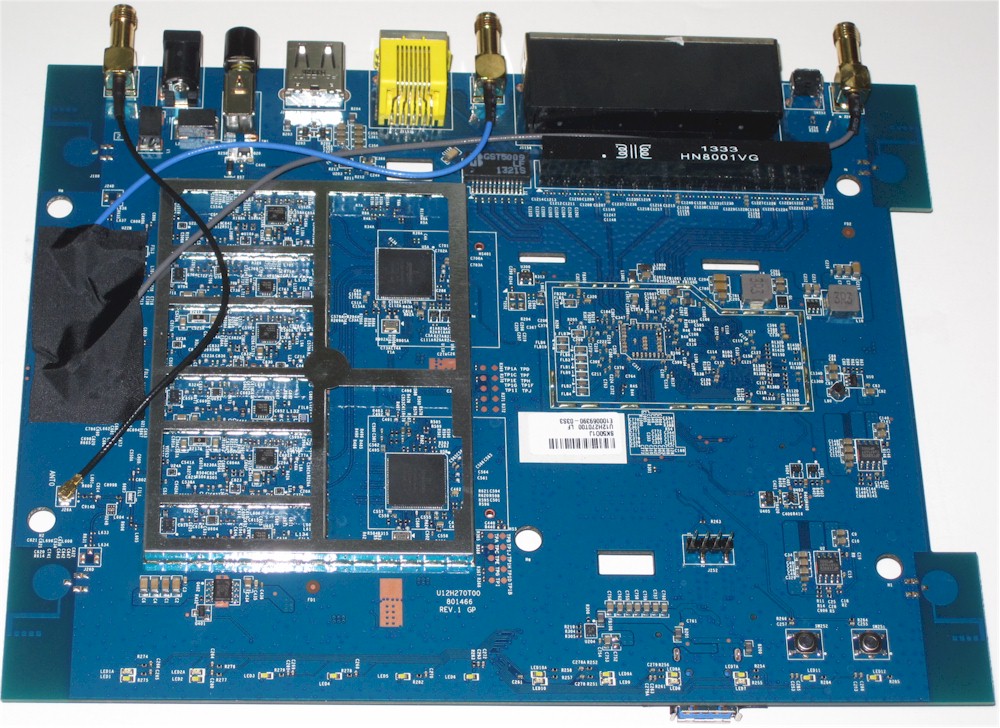
NETGEAR R7000 board top
There are more internal photos in the gallery below. The last photo shows a very large heatsink that sits at the bottom of the router and that is directly thremally-coupled to the RF shielded compartment that houses the BCM4709 SoC, RAM and flash.
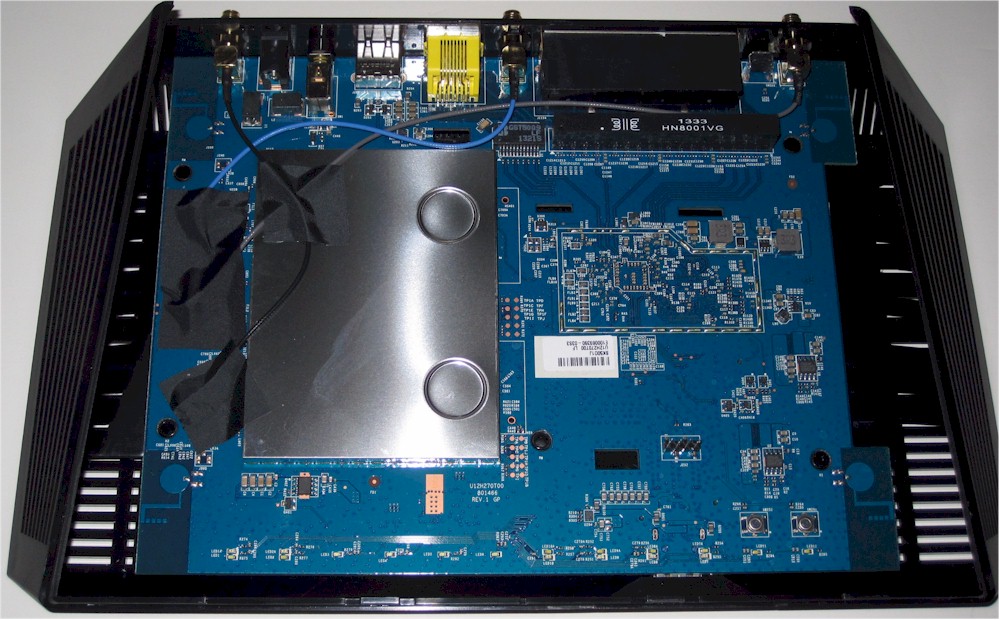
This is the view when you remove the cover.
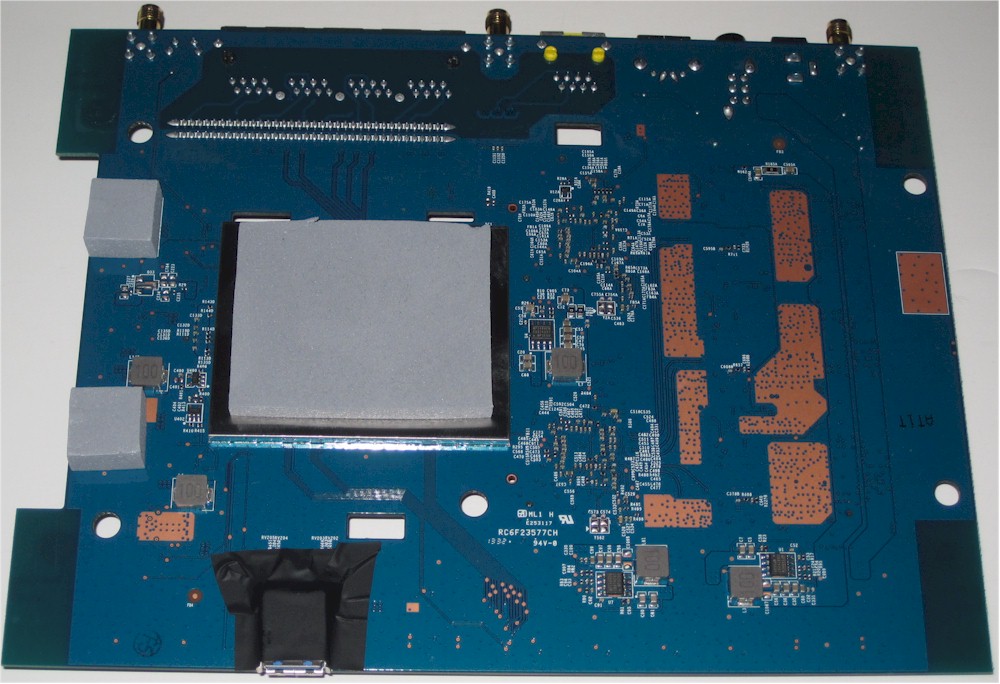
View with board removed and turned over. The grey pads thermally couple the main CPU and memory compartment to a very large heatsink in the bottom of the enclosure. The black tape is to reduce RF noise from the USB 3.0 connector.
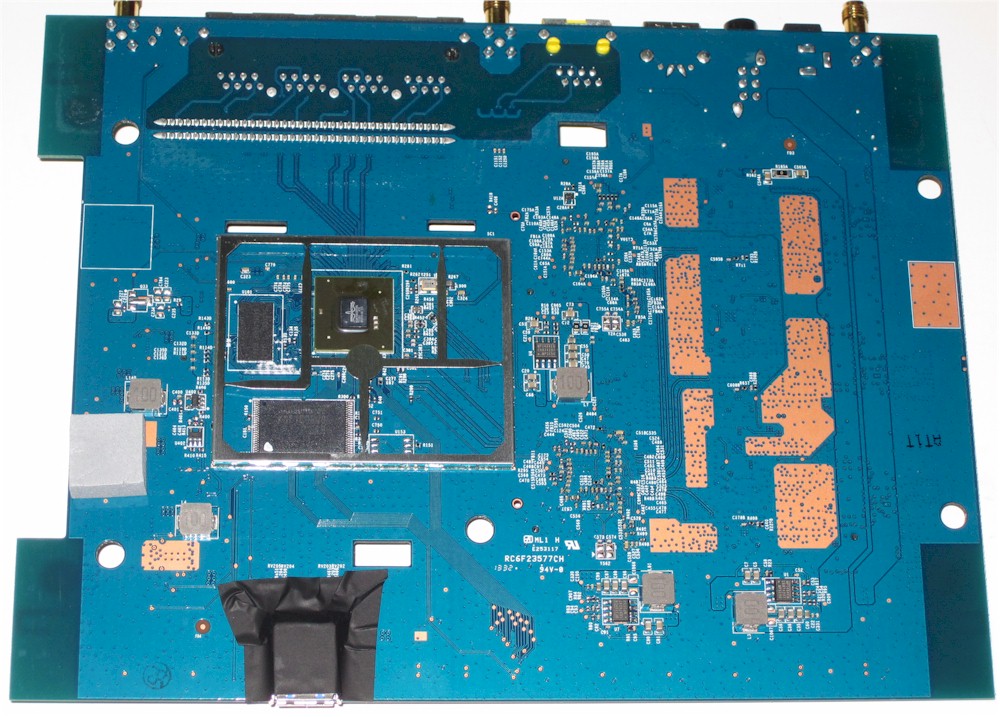
Here is the same view with the RF can top removed, exposing the Broadcom BCM4709 SoC, RAM and flash devices.

Here is the top view with the RF shield top removed. Those are two Broadcom BCM4360 3×3 802.11ac radios. The 2.4 and 5 GHz amplifiers sit side by side for each antenna channel.
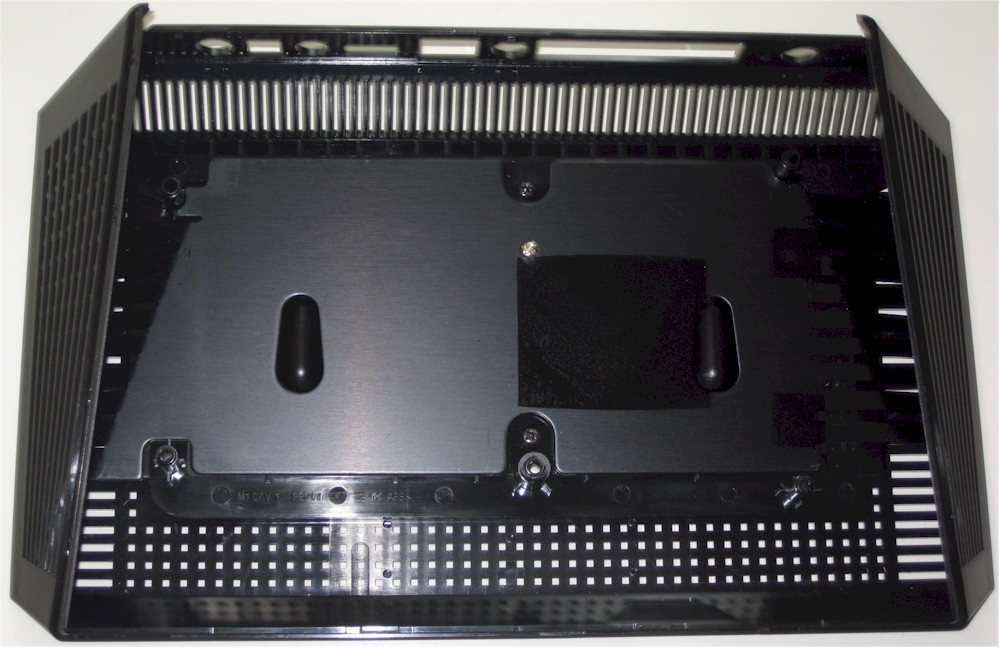
A large metal heatsink sits on the router floor. You can’t see it in this crappy photo, but both sides have metal fingers that extend to the side areas where cover grilles allow unobstructed bottom to top airflow. There is no fan in the router.
Here is a similar view of the ASUS board. It uses the same alternating arrangement for the outboard 2.4 and 5 GHz amplifiers. You can see one of the pads that thermally couple the amps to the RF compartment cover. All the devices have similar thermal coupling.
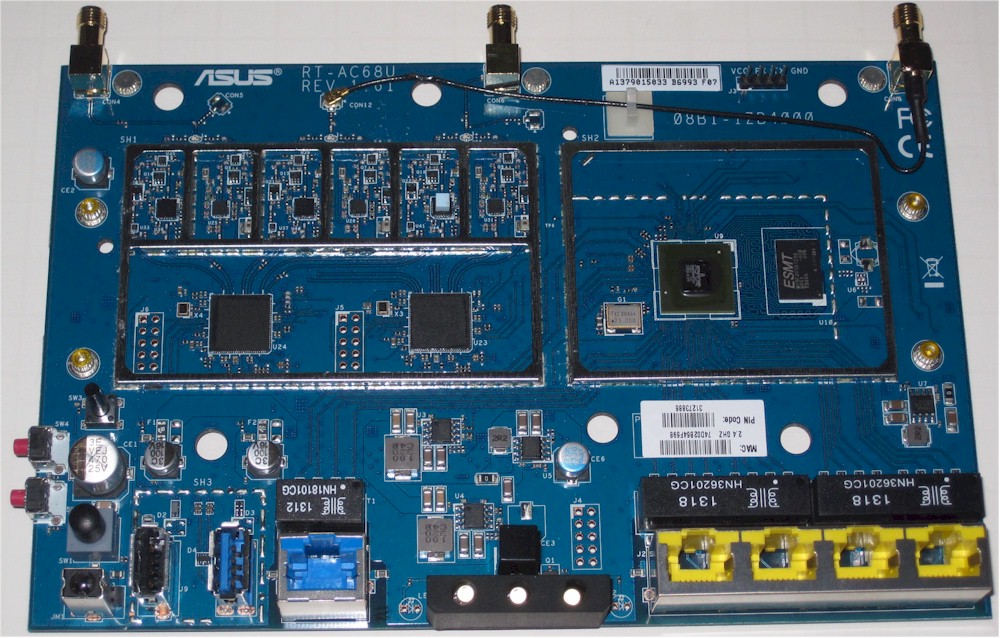
ASUS RT-AC68U board top

This is the view when you remove the cover.

View with board removed and turned over. The grey pads thermally couple the main CPU and memory compartment to a very large heatsink in the bottom of the enclosure. The black tape is to reduce RF noise from the USB 3.0 connector.

Here is the same view with the RF can top removed, exposing the Broadcom BCM4709 SoC, RAM and flash devices.

Here is the top view with the RF shield top removed. Those are two Broadcom BCM4360 3×3 802.11ac radios. The 2.4 and 5 GHz amplifiers sit side by side for each antenna channel.

A large metal heatsink sits on the router floor. You can’t see it in this crappy photo, but both sides have metal fingers that extend to the side areas where cover grilles allow unobstructed bottom to top airflow. There is no fan in the router.
According to Broadcom, the main difference between the two processors is that the 4709 has a 1 GHz clock speed per core, vs. 4708’s 800 MHz. The 4709 also supports faster DDR3-1600 memory and has "some other I/O" differences. So there is no overclocking involved, folks. NETGEAR simply chose a faster processor for the Nighthawk. Does NETGEAR (or ASUS for that matter) run the processors at full clock speed and do they enable access to all 256 MB? Who knows? All that matters in my book is performance, so let’s get right to it.
Storage Performance
Both products have one USB 2.0 port and one USB 3.0. Windows filecopy tests were run using the standard NAS testbed connected to a router Gigabit LAN port and the standard USB drive formatted in FAT32 and NTFS [NAS test details]. Tests were run connected with the USB drive connected to both the USB 2.0 and USB 3.0 ports.
Table 1 summarizes USB 2.0 performance and includes each product’s predecessor. You can see a big bump in performance for both products over the earlier models. The R7000 is more consistent for read and write and both FAT32 and NTFS. However, it maintains consistency with the R6300 in that FAT32 write is still the slowest.![]()
| NETGEAR R7000 | NETGEAR R6300 | ASUS RT-AC68U | ASUS RT-AC66U | |
|---|---|---|---|---|
| Processor | Broadcom BCM4709A | Broadcom BCM4706 | Broadcom BCM4708A | Broadcom BCM4706 |
| FAT32 Write (MBytes/s) | 24.8 | 8.6 | 11.8 | 9.0 |
| FAT32 Read (MBytes/s) | 27.8 | 10.2 | 24.0 | 9.9 |
| NTFS Write (MBytes/s) | 27.9 | 11.3 | 23.7 | 13.5 |
| NTFS Read (MBytes/s) | 27.9 | 10.3 | 24.2 | 9.4 |
Table 1: File copy throughput – USB 2.0 (MBytes/sec)
Switching to USB 3.0 results, we see some unprecedented results for both FAT32 and NTFS reads in Table 2. The Nighthawk gets within spittin’ distance of 60 MB/s for both formats, which is better than some SoC-based standalone NASes!![]() Note that I had to switch to AC1200 products for comparison because the R6200 and RT-AC66U have only USB 2.0 ports.
Note that I had to switch to AC1200 products for comparison because the R6200 and RT-AC66U have only USB 2.0 ports.
| NETGEAR R7000 | NETGEAR R6250 | ASUS RT-AC68U | ASUS RT-AC56U | |
|---|---|---|---|---|
| Processor | Broadcom BCM4709A | Broadcom BCM47081A | Broadcom BCM4708A | Broadcom BCM4708A |
| FAT32 Write (MBytes/s) | 33.4 | 15.9 | 11.7* | 19.8 |
| FAT32 Read (MBytes/s) | 57.4 | 25.6 | 21.6* | 47.2 |
| NTFS Write (MBytes/s) | 36.8 | 17.6 | 23.6* | 35.6 |
| NTFS Read (MBytes/s) | 57.7 | 25.7 | 24.3* | 52.2 |
Table 2: File copy throughput – USB 3.0 (MBytes/sec)
* = "Reducing USB 3.0 interference" setting enabled
You’ll note that the ASUS doesn’t do so well in this test. That’s because I had to enable the Reducing USB 3.0 interference setting, which appears to slow the USB 3.0 port to USB 2.0 speeds. I tried multiple times to get the tests to run, but each time the router share would disconnect while copying the first 1 GB VOB file in the test folder. Maybe ASUS should put some shielding on the USB 3.0 connector…
Routing Performance
Routing throughput was measured using our standard router test process. Table 3 summarizes the results and includes the NETGEAR R6300 and ASUS RT-AC66U for comparison.
All four routers have more routing throughput than most anyone can really use. But the best of the group is the R7000, with the highest throughput we’ve measured yet for all tests except LAN to WAN. That benchmark’s top position is occupied by TP-LINK’s Archer C7, which noses out the R7000 by an insignificant 1.2 Mbps at 942.9 Mbps. This is well within the margin of error of our test process, however.
Don’t assign any significence to the difference in the Maximum Simultaneous Connection results, except for the R6300. The 30,000+ sessions shown all represent results obtained when the test bumped into an in-use Windows port, which ended the test.
| Test Description | NETGEAR R7000 | NETGEAR R6300 | ASUS RT-AC68U | ASUS RT-AC66U |
|---|---|---|---|---|
| WAN – LAN | 931.4 Mbps | 783 Mbps | 754.5 Mbps | 836 Mbps |
| LAN – WAN | 941.7 Mbps | 829 Mbps | 824.6 Mbps | 839 Mbps |
| Total Simultaneous | 1378.3 Mbps | 808 Mbps | 1226.8 Mbps | 819 Mbps |
| Maximum Simultaneous Connections | 38,793 | 4,096 | 33, 263 | 30,069 |
| Firmware Version | V1.0.1.22_1.0.15 | V1.0.0.68_1.0.16 | 3.0.0.4.374_205 | 3.0.0.4.164 |
Table 3: Routing throughput
The IxChariot unidirectional composite plot for the R7000 shows rock-solid Gigabit wire-speed throughput in both directions.
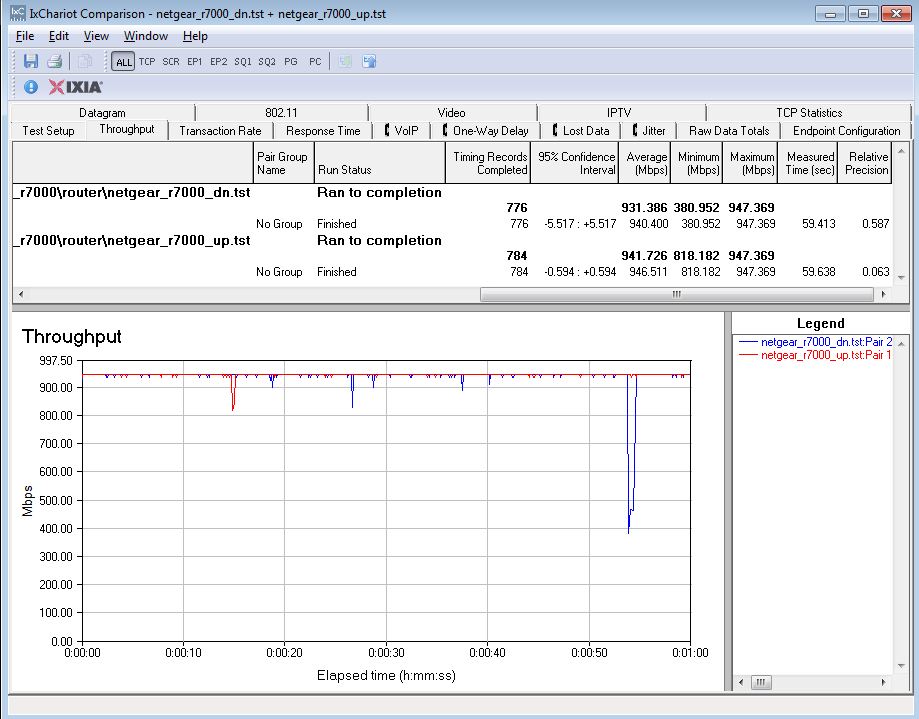
NETGEAR R7000 routing throughput unidirectional summary
The R7000 simultaneous up/downlink benchmark plot shows even distribution between up and downlink, even when variation rises after the 10 second mark.
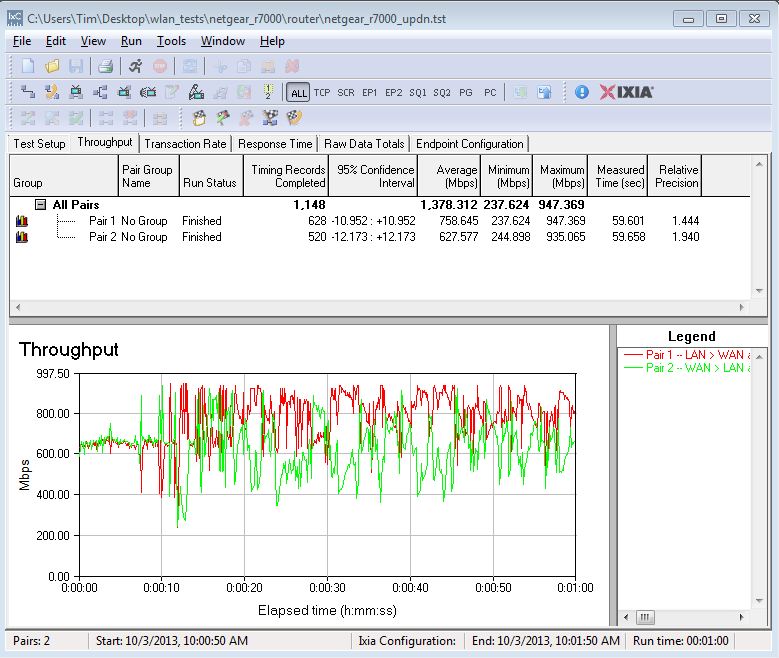
NETGEAR R7000 routing throughput bidirectional summary
Turning to the RT-AC68U, throughput is again pretty steady, but with more variation than the R7000 and lower values in both directions.
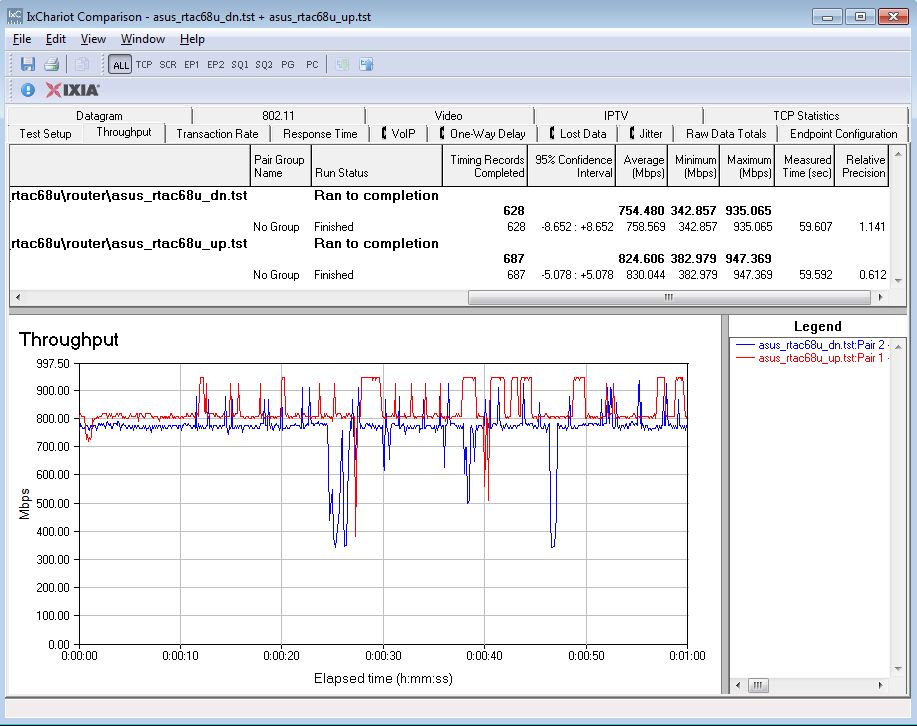
ASUS RT-AC68U routing throughput unidirectional summary
The AC68U simultaneous up/downlink benchmark plot seems to show the uplink (LAN to WAN) direction favored over downlink (WAN to LAN).
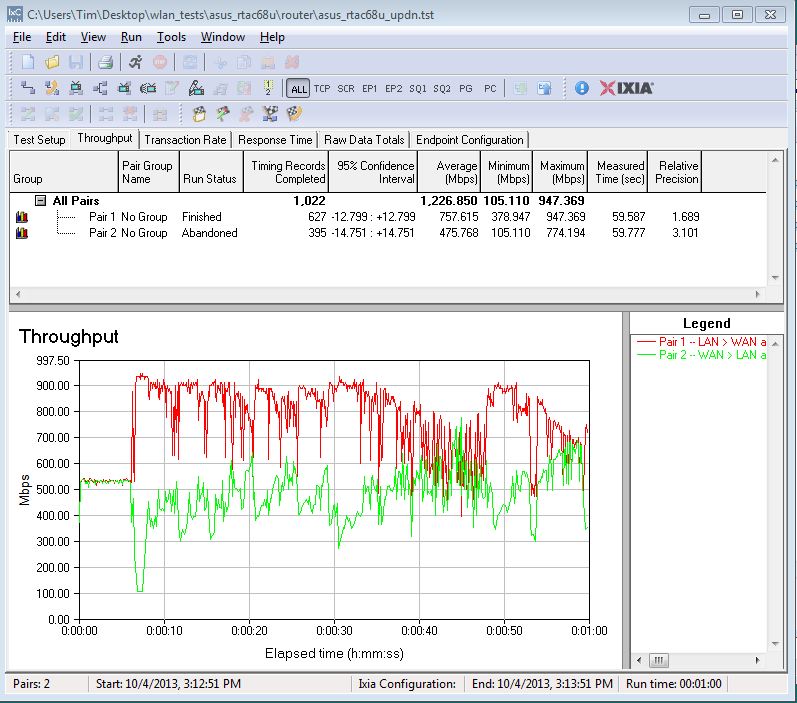
ASUS RT-AC68U routing throughput bidirectional summary
The overall results seem to indicate that the R7000 is getting enough of its more powerful processor’s attention—at least when storage and wireless aren’t also being hammered on.
Wireless Performance
As noted at the top of this review, I tested wireless performance using our standard wireless test process, which can test only up to AC1750 class routers. The R7000 is not Wi-Fi Certified, but the RT-AC68U is for 802.11a,b,g,n and ac.
Each router was first reset to factory defaults and Channel 6 was set for 2.4 GHz and Channel 153 for 5 GHz. 20 MHz bandwidth mode was set for 2.4 GHz and 80 MHz mode was set for 5 GHz. The test client was connected using WPA2/AES encryption.
The router were positioned 8" from the chamber antennas in the 0° and 180° test positions. Because of the width of both products and the tight quarters in the test chamber, the closest antenna in the 90° and 270° positions was more like 6 to 7 inches from the chamber antennas. The 0° position for both routers had the front facing the chamber antennas.
The R7000’s Benchmark Summary below shows the average of throughput measurements made in all test locations. Its 96 Mbps Average 2.4 GHz downlink places it one spot below the ASUS RT-N66U in that benchmark chart, while its 90 Mbps average uplink moves it a bit lower to the #4 spot below the N66U, ASUS RT-AC66U and TP-LINK Archer C7.
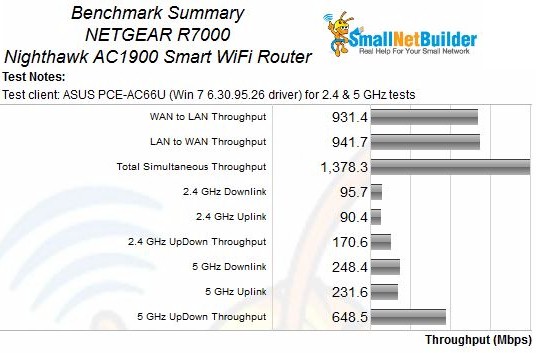
NETGEAR R7000 Benchmark Summary
Average 5 GHz results are a different story, with the R7000 taking top places in both downlink and uplink charts with results of 248 Mbps and 232 Mbps, respectively. It also topped the 5 GHz UpDown benchmark chart with a new high of 649 Mbps—40 Mbps higher than the second-place D-Link DIR-868L.
The RT-AC68U’s Benchmark Summary below shows its 80 Mbps Average 2.4 GHz downlink. This slots it at #8, far below the 99 Mbps of the RT-N66U that occupies the top position. When you look at the uplink rank, however, you have to scroll down pretty far to see the 43 Mbps uplink average. This is sure to throw some cold water on some prospective buyers…at least for awhile.
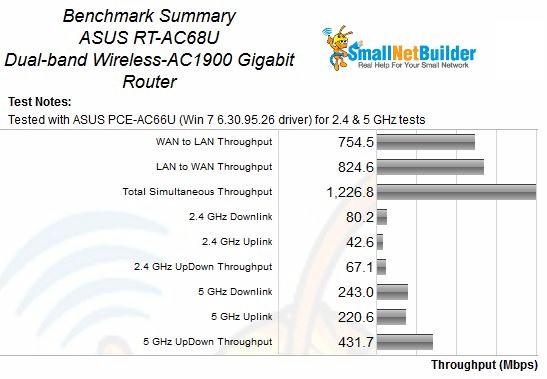
ASUS RT-AC68U Benchmark Summary
Average 5 GHz results get the AC68U back in the game with 243 Mbps downlink average, which puts it right below the R7000’s 248 Mbps. 5 GHz average uplink also has the two routers sitting right next to each other in that chart, albeit with the AC68U a bit lower at 221 Mbps vs. the R7000’s 232 Mbps. A second buzzkill for ASUS fanboys is the 5 GHz UpDown benchmark. The AC68U came in far below the R7000 with only 432 Mbps of total throughput vs. the R7000’s 649 Mbps.
But the real fun comes when looking at the throuhput vs. attenuation plots, which provide a much better view of relative performance. I included each product’s AC1750 class sibling in the charts, i.e. NETGEAR’s R6300 and ASUS’ RT-AC66U.
The 2.4 GHz downlink profile shows similar performance with low attenuation (higher signal levels). It looks like ASUS still has some tweaking to do with link rate selection in the strong-to-medium signal range since both the AC66U and AC68U have significant throughput dips in that part of the curves.
There is a clear difference between the products using the BCM4360 as the 2.4 GHz radio once attenuation passes 30 dB or so. Both the RT-AC66U and R6300 begin to fall off sooner, which puts them 30 Mbps or so below both the AC68U and R7000 after 51 dB of attenuation. Note that the two AC1750 class and AC1900 class products track together pretty closely as attenuation increases above 50 dB.
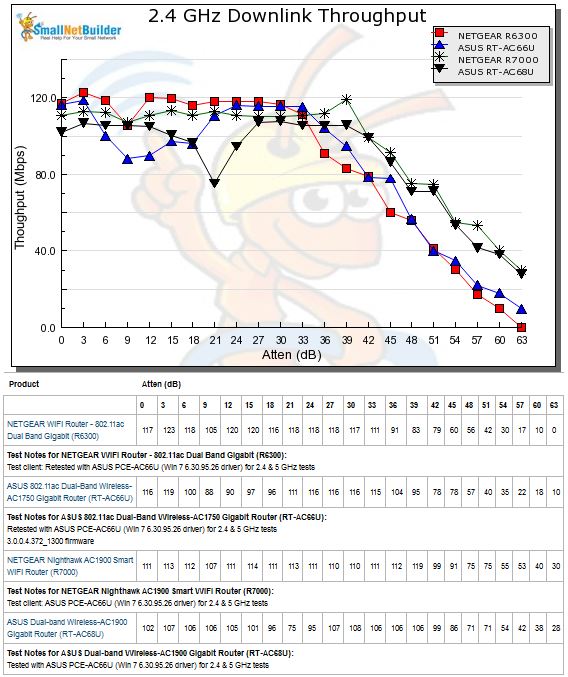
2.4 GHz Downlink Throughput vs. Attenuation
The 2.4 GHz uplink plot shows three of the four products tracking remarkably closely up to 30 dB of attenuation. The RT-AC68U clearly has a problem with this benchmark, which I assume ASUS will be able to straighten out via a firmware update. So I’ll probably be taking the AC68U through another tour in the test chamber for the full review.
This time, it’s the older RT-AC66U that tracks with the newer R7000 as signal levels drop.
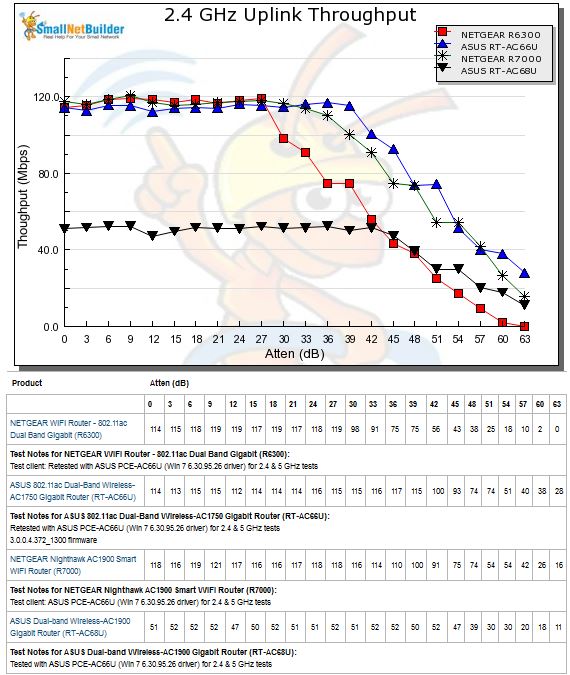
2.4 GHz Uplink Throughput vs. Attenuation
Wireless Performance – more
The 5 GHz downlink profiles show a clear pattern for both up and downlink. The worst performer in the group is the NETGEAR R6300, which starts out lower than the others and stays that way throughout the entire tested attenuation range. The ASUS RT-AC66U takes the middle road to end up with still 55 Mbps of throughput at the maximum 45 dB attenuation.
Both newer AC1900 router track together pretty well as attenuation rises above 24 dB, with both products still producing more than 100 Mbps of throughput at 45 dB maximum attenuation. This means both should produce better 5 GHz range than their AC1750 class siblings.
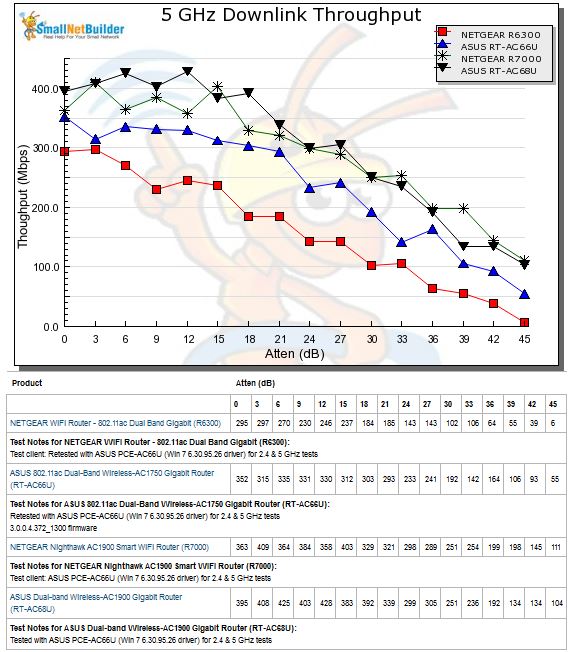
5 GHz Downlink Throughput vs. Attenuation
The 5 GHz uplink plot shows the AC68U with significantly higher throughput at low attenuation, except for the 0 dB point that we use for throughput ranking. But throughput steps down at 15 dB of attenuation then tracks closely with the R7000 for the rest of the test run.
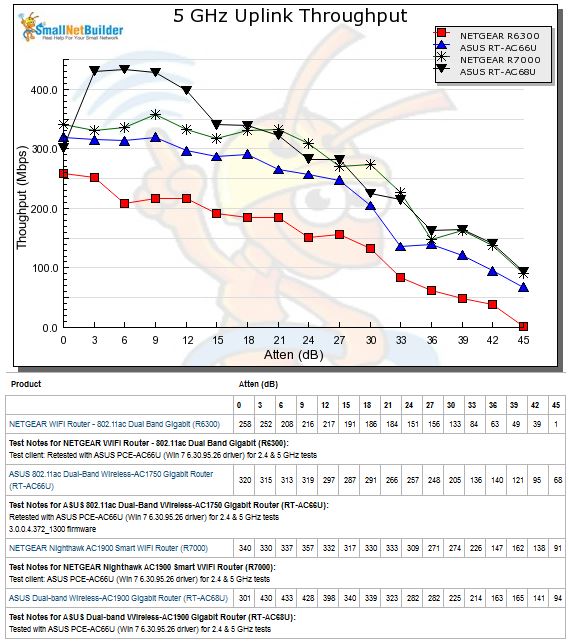
5 GHz Uplink Throughput vs. Attenuation
The bottom line is that both the RT-AC68U and R7000 should provide a nice increase in 5 GHz range over their AC1750 brethren for both uplink and downlink. 2.4 GHz is more difficult to call. You might see better range running downlink and even uplink. But I suspect you’ll definitely detect a reduction in 2.4 GHz speed at high to moderate signal levels that will more strongly influence your wireless experience.
Wireless Performance – AC1900
Since NETGEAR sent a second R7000 configured as a bridge so that I could experience the wonder of 600 Mbps in 2.4 GHz, I ran some quick open-air tests. I kept the R7000 in the upper test chamber with the door open and put the second R7000 configured as a client (non WDS) bridge on the floor. This put them about 6 feet from each other.
I also shut off all other 2.4 GHz networks in the house to give the two R7000’s the best chance at getting a 600 Mbps link. But since the R7000 doesn’t provide any way to see the link rate (or signal strength, or show the possible networks to connect to) in its wireless bridge settings, I had no way of knowing the rate it actually connected at.
Truth be told, I initially tried to run tests with the PCE-AC68 card that ASUS also sent. But despite multiple attempts, I could never get a link rate above the 450 Mbps seen for AC1750 products (and N900 too). Broadcom confirmed that the current PCE-AC68 driver doesn’t enable TurboQAM by default. So test runs over the full signal range will have to wait until ASUS provides an updated driver.
After confirming that the routing R7000’s 2.4 GHz radio was set to its Up to 600 Mbps mode, I ran tests between the two R7000s and also the R7000 router and the PCE-AC68 card. For the latter tests, I pulled the test computer out of its lower test chamber and connected the card’s antennas.
The IxChariot plot below compares the downlink results obtained by the two methods. Since the PCE-AC68 card was acting like an AC1750 client, the plot shows an almost 2X throughput improvement from an (I assume) 600 Mbps link-rate connection and a 450 Mbps link rate connection.
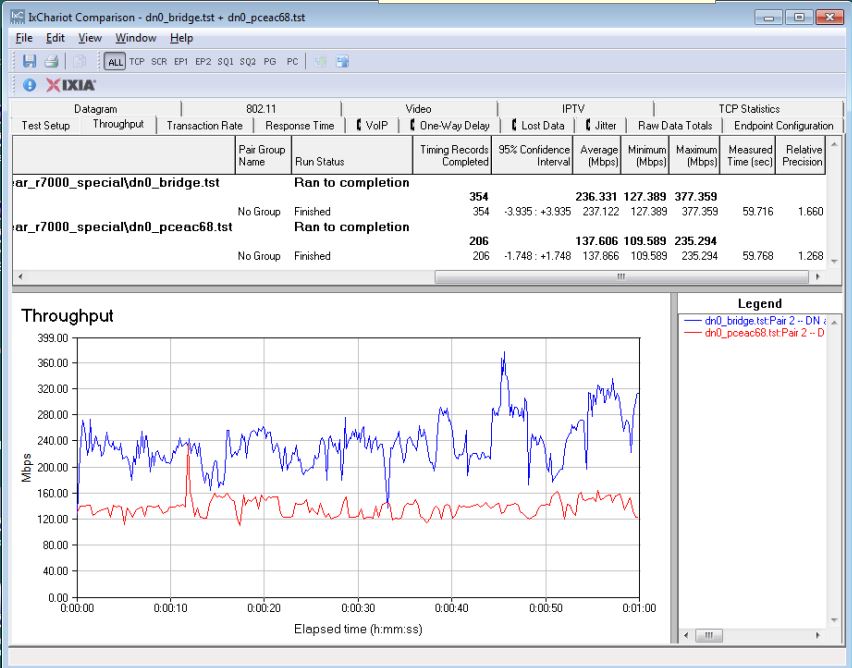
2.4 GHz 600 Mbps link test – downlink
Uplink results were a puzzle, however. This time the 450 Mbps link rate PCE-AC68 connection provided slightly higher throughput than the R7000 bridge.
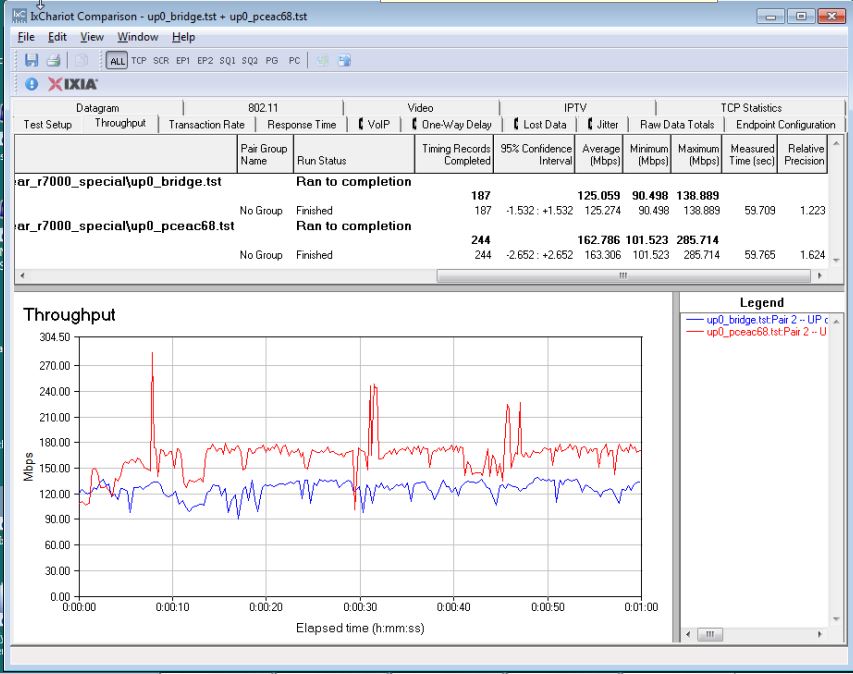
2.4 GHz 600 Mbps link test – uplink
I shared these results with NETGEAR and they said they have obtained 400+ Mbps throughput in their RF-tight test chamber running an R7000 router to R7000 bridge tests. They thought the computers used in the test could be limiting throughput as well as the physical setup.
Closing Thoughts
With only two AC1900 routers to show, the Router Ranker results are pretty uninteresting. But for the record, they show the NETGEAR R7000 Nighthawk in the #1 position and the ASUS RT-AC68U as number 2.
AC1900 is mainly a marketing ploy to make you feel like you are getting something extra for the higher price you’ll pay. And extra you will pay because you’ll need two of whatever you buy to get that magic 600 Mbps link rate. But your chances of getting 600 Mbps are even lower due to other factors I’ll cover in another article that will post in the next day or so.
Even with these preliminary results, I don’t recommend buying either of these products if you already have an AC router. At $200 or more, you’re paying at least $40 more than you have to for an AC1750 class router that, for all practical purposes, is going to be just as good.
But if you simply must have one, I’d have to say the NETGEAR is the better choice. But that’s mainly because its (slightly) faster processor has more power to handle heavier simultaneous routing, wireless and storage loads, with significantly higher storage performance being the real benefit for your $200.
 Buy Nighthawk AC1900 Smart WiFi Router from Amazon
Buy Nighthawk AC1900 Smart WiFi Router from Amazon
